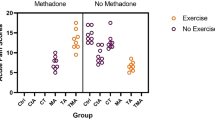Abstract
Rationale
Social support and opioid replacement therapy are commonly used to treat opioid withdrawal.
Objective
The present study tested the hypothesis that social housing and buprenorphine administration can restore wheel running depressed by morphine withdrawal in rats.
Results
Experiment 1 assessed disruptive side effects of buprenorphine and found that administration of low doses (3.2, 10, & 32 µg/kg, s.c.) had no impact on voluntary wheel running. Experiment 2 assessed the impact of social housing and acute buprenorphine administration (10 µg/kg) on morphine withdrawal. Two 75 mg morphine pellets were implanted for 3 days to induce dependence. Removal of the morphine pellets caused a decrease in body weight, increase in wet dog shakes, and depression of wheel running during the normally active dark phase of the circadian cycle. Social housing restored wheel running and reduced the number of wet dog shakes but did not affect body weight. Administration of buprenorphine restored wheel running depressed by morphine withdrawal for 2 days in individually housed rats and produced time-dependent changes in socially housed rats: Depression of wheel running in the 3 h following administration and restoration of running subsequently compared to saline-treated controls.
Conclusions
The impact of buprenorphine and social housing to reduce the effect of morphine withdrawal in rats is consistent with the use of opioid substitution therapy and psychotherapy/social support to treat opioid withdrawal in humans. These data provide further validation for the clinical relevance for the use of wheel running to assess spontaneous opioid withdrawal.





Similar content being viewed by others
References
Alderks CE (2013) Trends in the use of methadone, buprenorphine, and extended-release naltrexone at substance abuse treatment facilities: 2003–2015 (update). In: The CBHSQ Report. Substance Abuse and Mental Health Services Administration (US), Rockville (MD)
Alizadeh M, Zahedi-Khorasani M, Miladi-Gorji H (2018) Treadmill exercise attenuates the severity of physical dependence, anxiety, depressive-like behavior and voluntary morphine consumption in morphine withdrawn rats receiving methadone maintenance treatment. Neurosci Lett 681:73–77. https://doi.org/10.1016/j.neulet.2018.05.044
Bart G (2012) Maintenance medication for opiate addiction: the foundation of recovery. J Addict Dis 31:207–225. https://doi.org/10.1080/10550887.2012.694598
Benhamou O-M, Lynch S, Klepacz L (2021) Case report: buprenorphine—a treatment for psychological pain and suicidal ideation? Am J Addict 30:80–82. https://doi.org/10.1111/ajad.13063
Bruijnzeel AW, Marcinkiewcz C, Isaac S et al (2007) The effects of buprenorphine on fentanyl withdrawal in rats. Psychopharmacology 191:931–941. https://doi.org/10.1007/s00213-006-0670-2
Cerletti C, Keinath SH, Reidenbery MM, Alder MW (1976) Chronic morphine administration: plasma levels and withdrawal syndrome in rats. Pharmacol Biochem Behav 4:323–327. https://doi.org/10.1016/0091-3057(76)90249-5
Gellert VF, Holtzman SG (1978) Development and maintenance of morphine tolerance and dependence in the rat by scheduled access to morphine drinking solutions. J Pharmacol Exp Ther 205:536–546
Gregory VL, Ellis RJB (2020) Cognitive-behavioral therapy and buprenorphine for opioid use disorder: a systematic review and meta-analysis of randomized controlled trials. Am J Drug Alcohol Abuse 46:520–530. https://doi.org/10.1080/00952990.2020.1780602
Havassy BE, Hall SM, Wasserman DA (1991) Social support and relapse: commonalities among alcoholics, opiate users, and cigarette smokers. Addict Behav 16:235–246. https://doi.org/10.1016/0306-4603(91)90016-b
Kandasamy R, Calsbeek JJ, Morgan MM (2016) Home cage wheel running is an objective and clinically relevant method to assess inflammatory pain in male and female rats. J Neurosci Methods 263:115–122. https://doi.org/10.1016/j.jneumeth.2016.02.013
Kandasamy R, Lee AT, Morgan MM (2017) Depression of home cage wheel running is an objective measure of spontaneous morphine withdrawal in rats with and without persistent pain. Pharmacol Biochem Behav 156:10–15. https://doi.org/10.1016/j.pbb.2017.03.007
Kandasamy R, Morgan MM (2021) “Reinventing the wheel” to advance the development of pain therapeutics. Behav Pharmacol 32:142–152. https://doi.org/10.1097/FBP.0000000000000596
Ling W, Hillhouse M, Ang A et al (2013) Comparison of behavioral treatment conditions in buprenorphine maintenance. Addiction 108:1788–1798. https://doi.org/10.1111/add.12266
Manhapra A, Agbese E, Leslie DL, Rosenheck RA (2018) Three-year retention in buprenorphine treatment for opioid use disorder among privately insured adults. Psychiatr Serv 69:768–776. https://doi.org/10.1176/appi.ps.201700363
Mogil JS (2015) Social modulation of and by pain in humans and rodents. Pain 156(Suppl 1):S35–S41. https://doi.org/10.1097/01.j.pain.0000460341.62094.77
Morgan MM, Peecher DL, Streicher JM (2021) Use of home cage wheel running to assess the behavioural effects of administering a mu/delta opioid receptor heterodimer antagonist for spontaneous morphine withdrawal in the rat. Behav Brain Res 397:112953. https://doi.org/10.1016/j.bbr.2020.112953
National Research Council (U.S.), Institute for Laboratory Animal Research (U.S.), National Academies Press (U.S.) (eds) (2011) Guide for the care and use of laboratory animals, 8th ed. National Academies Press, Washington, D.C
Negus SS (2018) Addressing the opioid crisis: the importance of choosing translational endpoints in analgesic drug discovery. Trends Pharmacol Sci 39:327–330. https://doi.org/10.1016/j.tips.2018.02.002
Nyhuis PW, Gastpar M, Scherbaum N (2008) Opiate treatment in depression refractory to antidepressants and electroconvulsive therapy. J Clin Psychopharmacol 28:593–595. https://doi.org/10.1097/JCP.0b013e31818638a4
Stickney JD, Morgan MM (2021) Social housing promotes recovery of wheel running depressed by inflammatory pain and morphine withdrawal in male rats. Behav Brain Res 396:112912. https://doi.org/10.1016/j.bbr.2020.112912
Stinus L, Cador M, Zorrilla EP, Koob GF (2005) Buprenorphine and a CRF1 antagonist block the acquisition of opiate withdrawal-induced conditioned place aversion in rats. Neuropsychopharmacology 30:90–98. https://doi.org/10.1038/sj.npp.1300487
Stoller DC, Smith FL (2004) Buprenorphine blocks withdrawal in morphine-dependent rat pups. Paediatr Anaesth 14:642–649. https://doi.org/10.1111/j.1460-9592.2004.01264.x
Acknowledgements
Technical assistance from Kristin Ataras, Keziah-Khue Nguyen, and Mary Macpherson is appreciated.
Funding
This investigation was supported by funds provided for medical and biological research by the State of Washington Initiative Measure No. 171.
Author information
Authors and Affiliations
Corresponding author
Ethics declarations
Conflict of interest
The authors declare no competing interests.
Additional information
Publisher's note
Springer Nature remains neutral with regard to jurisdictional claims in published maps and institutional affiliations.
Rights and permissions
About this article
Cite this article
Stickney, J.D., Morgan, M.M. Comparative benefits of social housing and buprenorphine on wheel running depressed by morphine withdrawal in rats. Psychopharmacology 238, 2895–2903 (2021). https://doi.org/10.1007/s00213-021-05906-8
Received:
Accepted:
Published:
Issue Date:
DOI: https://doi.org/10.1007/s00213-021-05906-8




